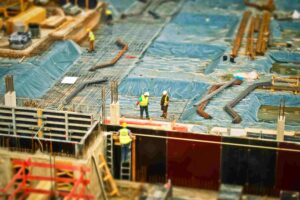In the hustle and bustle of construction, it’s easy to overlook the importance of edge protection. However, this seemingly minor detail can make a significant difference in the overall success of your project. Proper edge protection safeguards your workers from injury and protects your project from damage and delays.

What is Edge Protection?
Edge protection refers to the barriers or enclosures that are installed around exposed edges of construction sites to prevent falls and protect materials from damage. These barriers can be made from various materials, including hoarding panels, bubble board, polyweave, and PVC panels.
Why is Edge Protection Important?
Edge protection is essential for several reasons:
1. Protects materials: Edge protection can help to prevent materials from being damaged during construction. This can save you money and time eventually.
2. Improves site safety: Edge protection makes your construction site safer for everyone involved, including workers, visitors, and the public.
3. Project Efficiency: By minimizing disruptions and accidents, edge protection способствует the smooth operation of the construction or renovation project.
4. Unauthorized Access: Clearly marked and secured edge protection barriers deter unauthorized entry to construction sites, safeguarding the integrity of materials, equipment, and the overall project.
5. Fall Prevention: Falls from heights are a leading cause of serious injuries and fatalities in the construction industry. Edge protection systems, such as guardrails and safety nets, prevent individuals from falling from elevated surfaces, minimizing the risk of severe harm.
6. Debris Control: Construction sites inevitably generate debris and dust. Edge protection, such as dust curtains and debris netting, helps contain these materials, preventing them from spreading onto public areas, obstructing traffic, or causing environmental hazards.
What are the Different Types of Edge Protection?
There are several types of edge protection available, each with its advantages and disadvantages. Some of the most common types of edge protection include:
1. Hoarding panels: Hoarding panels are large, freestanding barriers that are typically made from wood or metal. They are often used to secure construction sites and prevent unauthorized access.
2. Bubble board: Bubble board is a lightweight, flexible material that is frequently used to protect walls and corners. It is easy to install and remove, and it can be reused multiple times.
3. Polyweave: Polyweave is a durable, woven material that is often used to protect floors. It is resistant to tears and punctures, and it can be easily cleaned.
4. PVC panels: PVC panels are rigid, plastic panels that are regularly used to create temporary walls. They are easy to install and remove, and they can be painted or decorated.
5. Sticky Mat: This adhesive mat effectively captures dust and debris, preventing them from spreading beyond the worksite.
6. Core Flute: A corrugated plastic material, core flute is commonly used for signage and partitions due to its strength and versatility.
7. Protective Foam: Soft and shock-absorbing foam is used to protect edges and corners from damage.
8. Floor Protection: Plastic floor protectors safeguard floors from damage caused by heavy equipment and foot traffic.
Edge Protection Installation Techniques
Proper installation of edge protection is essential for its effectiveness:
1. Secure Foundation: Ensure the hoarding or barrier is firmly anchored to the ground or existing structure to prevent tipping.
2. Height Considerations: Adjust the height of the protection according to the hazard level and the type of work being performed.
3. Gap Elimination: Close any gaps or openings between panels to prevent debris from escaping or people from entering restricted areas.
4. Signage and Warnings: Clearly mark hazardous areas with warning signs and tape to alert workers and pedestrians.
How to Choose the Right Edge Protection for Your Project
The type of edge protection you choose will depend on the specific needs of your project. Here are some factors to consider:
1. The height of the fall hazard: If the fall hazard is less than 6 feet (1.83 m), you may only need to use a simple guardrail. However, if the fall hazard is greater than 6 feet (1.83 m), you will need to use a more robust form of edge protection, such as a safety net.
2. The type of material you are protecting: If you are protecting delicate materials, you will need to use a softer material, such as bubble board or acoustic curtains. However, if you are protecting heavy materials, you can use a more durable material, such as polyweave or PVC panels.
3. The budget for your project: Edge protection can range in price from a few hundred dollars to several thousand dollars. It is important to factor in the cost of edge protection when you are budgeting for your project.
Installing Edge Protection
The installation of edge protection will vary depending on the type of edge protection you choose. However, there are some general guidelines that you should follow:
• Make sure that the edge protection is securely fastened to the ground or structure.
• Inspect the edge protection regularly to make sure that it is in good condition.
• Replace any damaged edge protection immediately.
Tips for Effective Edge Protection
Here are a few additional tips for effective edge protection:
• Train your workers on the importance of edge protection.
• Make sure that edge protection is always in place when work is being done.
• Inspect your edge protection regularly and make repairs as needed.
By following these tips, you can help to ensure that your project is safe and secure.
Conclusion
Edge protection is an essential part of any construction project. By taking the time to plan and implement proper edge protection, you can help to prevent injuries, protect your materials, and improve the overall safety of your site.

